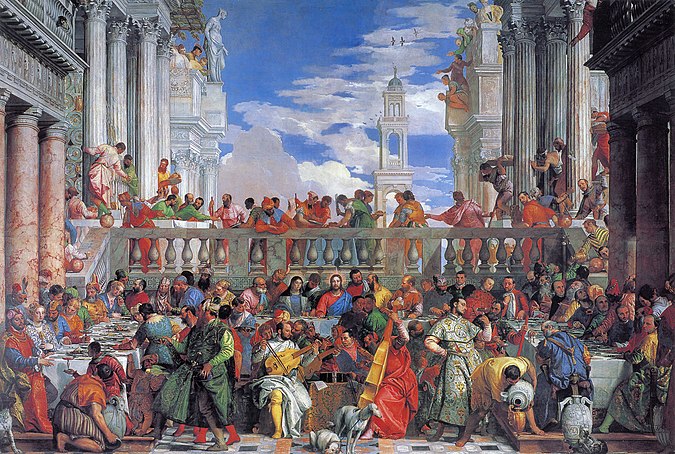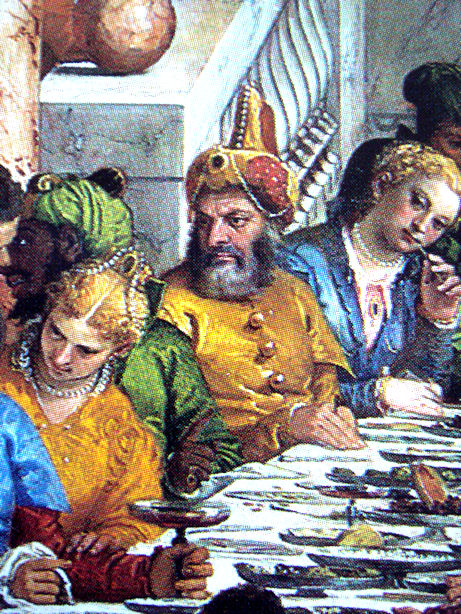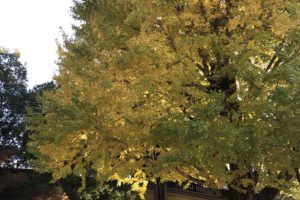January 16, 2022
Nara Christ Church Donald M. Seekins
The Wedding at Cana
Let me say first that I don’t know how many theological toes I am treading on in these remarks. I have no formal theological training, but these are my opinions. They are definitely not a Sermon.
As described in the Gospel of John, the Wedding (or marriage feast) at Cana, in Galilee, was the first place where Jesus performed a miracle, turning water into wine. A church at the presumed site is found in Israel today. The wedding, attended by Jesus, his mother and his disciples, became a popular theme in western religious art, especially during the Renaissance. In 1563, an Italian painter, Paolo Veronese, created what is one of the most spectacular – and worldly, if that isn’t a contradiction – religious paintings in history, La Nozze di Cana.
Veronese painted big. The canvas on which La Nozze is painted is almost 67.3 square meters, which means that it is about as large, or larger, than many apartments in Nara. It was originally commissioned by the monastery of San Giorgio on an island near Venice. But in 1797, Napoleon, campaigning in Italy, looted it and carried it back to France and it remains at the Louvre today. I wonder if his soldiers took it back to France in its frame, or rolled it up?
What is most interesting about this painting is how it blends an originally religious theme with worldly considerations. The painting is a bit like a People Magazine’s “celebrities of the year” article set in the sixteenth century. Jesus is seated at the centre of the table, flanked by many, many other celebrants. There are a total of 130 figures in the painting, male and female. They include major Renaissance figures such as King François I of France, his rival Charles V, the Holy Roman Emperor (and King of Spain), Mary I of England (the infamous Mary Queen of Scots, known as “Bloody Mary” by Protestants), and – most surprising to me – Suleiman the Magnificent, the tenth sultan of the Ottoman Empire and one of its greatest rulers. He is accompanied by an Ottoman diplomat, Sokulu Mehmet Pasha. To the right of the sultan is a person who seems to be his bodyguard; also, he seems to be African. Of course, neither Martin Luther nor John Calvin were invited to the party. But the inclusion of one of the most powerful Muslim rulers of the sixteenth century is intriguing. One reason may be that Suleiman had an alliance with King François I, since France was locked in unending wars with its biggest rival, the Holy Roman Empire. Just as America and its communist adversaries trampled on Indochina during the 1960s and 1970s, so France and the Holy Roman Empire treated Italy as a doormat upon which marched their armies. On the matter of there being no wine at the wedding feast, one would think Suleiman would be indifferent, being Muslim. He is shown, looking a little impatient, perhaps waiting to receive a cup of strong Turkish coffee from his hosts.
Suleiman was a ladies’ man: he had a very large harem in the Topkapi Palace in Istanbul, including the Ukranian woman Roxelana who later became his chief wife and was known in Turkish history as Hurrem Sultan. Seated next to Suleiman is not Hurrem but an attractive blond woman who seems less than overwhelmed at her proximity to the “Khan of Khans”: she’s busy trying to dislodge a bit of food from her teeth with a toothpick. The painter himself, Veronese, is portrayed as a member of the orchestra, along with other artists such as Tintoretto and Titian.
Veronese’s painting seems more about the geopolitics of sixteenth century Europe than Jesus’ miracle. Yet its scale and grandeur are awe-inspiring. He may not have been the best painter the Italian Renaissance produced, but it’s humbling for us to realize that no contemporary artist could even approach La Nozze di Cana in skill. One of the many sad things about our twenty-first century is the steady decline of the visual arts. Soon, robots will be painters instead of people.
Veronese’s work shows that religion, art and politics are not completely separate spheres of life, but closely intertwined. In our age, religion seems in decline, but appreciation of art remains strong. I suppose in a hundred years, visitors to the great cathedrals of Europe will appreciate their beauty and grandeur, but have no understanding of why they were built. In much the same way, I often think that the Buddhist temples in Kyoto and Nara are primarily appreciated by Japanese as objects of artistic beauty rather than having a spiritual or religious meaning. But draining a site or a work of art of its spiritual significance in the name of beauty, I feel, is essentially draining it of its soul.
To be frank, the miracles of Jesus do not occupy my mind very much. One can either dismiss them as superstitious nonsense or signs of Christ’s often hidden, but very real divinity. Save for the Resurrection of Jesus, miracles do not seem to be mentioned in the Nicene Creed of 325 CE. It is not Jesus the man who turns water into wine, but the Father, who is omniscient and omnipotent. And miracles are not confined to Christianity. Buddha was said in one legend to have flown through the air from his home in India to central Burma, where he landed on Mandalay Hill. He foretold that a glorious royal city would be founded at the base of the hill exactly 2,400 years later.
We live in a world where most people educated in science believe the Universe has no inherent moral character. Although generally orderly, it operates unceasingly according to physical laws that have little if any regard for mortal humans. To believe in miracles seems to be equivalent to thinking that on certain occasions God intervenes in human history to suspend the natural processes. And that He has His own reasons for doing this. There is no way that water can be turned into wine through a natural process, but God Himself can do it. This, again, is not exclusively Christian, as we all know. The pagan Romans believed that their gods intervened in Rome’s wars against its many enemies, and made generous sacrifices to them; the Chinese believed that earthquakes and other natural disasters were caused by the displeasure of Heaven with the ruling emperor rather than the friction caused by geological faults.
The issue of miracles in the Bible seems to be similar to that of slavery. No one today can justify slavery as an institution. But the Bible seems to accept it as part of the natural order. Once, I heard a Baptist minister say that Christians should see themselves as God’s slaves. I myself find that a very repulsive doctrine.
Just as we should not condone slavery simply because it is taken for granted in the Bible, I don’t think that denying the major significance of miracles in the New Testament is really to challenge the foundations of the Christian religion. The central message of Christianity, I believe, is God is Love. Which is mysterious and extremely difficult to understand.















